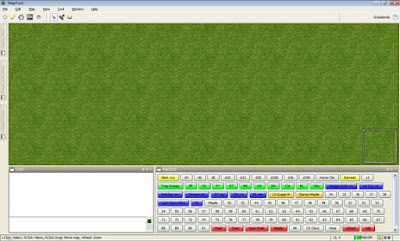Ok, I was going to go over the basic layout, but what good does knowing where stuff is if you can't connect to a game?
After getting the game downloaded and installed, you will (of course) want to run it. As the program runs you may or may not see a brief Java splash screen, but you should see a MapTools start-up splash screen. Please note in the lower left hand corner the version number of your program should be visible. This is especially important if you happen to be have different versions of MapTools on your computer. For a while I was playing in a 1.2 game and a 1.3 game.
6/10/12 Update: We're up to using build 86 (1.3b86) in our games now

Anyway, the program will load and you'll get the default layout.....which will not look much like the screen shot of my layout because MapTools likes to remember how you had things since last time you ran the program. If you get to this point, by all means poke around a bit...when you're ready to continue just read on....

Finished?
Good. Everything you'll need to know to start up or connect to a MapTools game is located under the File tab (Alt-F). I recommend going on down to Start Server. You'll see a pop-up window that looks like this:

Most of it is pretty easy to thumb through, but I'll go through each box anyway because I am trying to do some sort of tutorial here.
Username: Put in a user name here. Even though the program will let you I highly recommend you refrain from making a long username or creating one with a space. For the most part it doesn't matter, but later on if someone wants to send you a whisper in chat, they have to be able to type your name.....and spaces will be seen as part of the message so the chat program will just keep telling the sender that the user they wish to speak with doesn't exist. Backend kind of blows problem that is easily remedied by not being a dumbass on the front end.
GM/Player: After the username you can specify if you are going to be a player or the GM. MapTools allows multiple people to be GMs and the person hosting the game doesn't have to be
a GM.
Port: This is the port that MapTools uses to speak to the outside world through your firewall. You DO have a firewall right? Instead of having a piece of software demand to use a specific port and you have to make sure your firewall will work, you can work the other way around.
RPTools.net Name: You can basically have the RPTools server keep track of your IP info for you so you don't have to give out the IP address to every single player. Many/Most home users don't really have a static IP address anyway, so a whole lot of PITA can be bypassed by keeping your game registered (so to speak) with RPTools.net You can also make the game private so people searching for your game canot find you. Unless you have problems with unexpected visiotors dropping in, don't be that guy and make your game private. Better off just not using the registry.
GM Password: You can require your GMs to log on with a password. Keeps players from logging in as GMs and doing stuff they shouldn't.
Player Password: Just like the GM password but more usefull to keep unwanted players from logging on.
Options: Here you can make it so only the token's owner can do stuff to the tokens on the map (not recommended, more later) and enable the players to reveal the fog of war depending on where their minis could see.
Test Connection: I highly recommend clicking on this button before hitting "OK". MapTools will do a quick test to make sure that people using the connection information you entered could see your computer. I've had some issues where people had a different IP than what they thought they had.....often because their survice provider changed it on them since last time they used MapTools.

Yeah....now on to connecting as a player.
The first thing you should think about is if you are connecting via a local connection or over the internet. One of the strengths of MapTools over it's competitors (or at least those I've played with) was that if you had a player on your LAN and another connecting in over the internet it was easy to do. The easiest way of getting the information you need is to go to File: Connection Information. There will be your internal and external IP in all it's glory. If you have a server running the server name and open port will be showing too.

Going back to File: Connect to Server brings up a slightly different menu than the server start-up, but several of the same elements are there. The only real thing to note is that odds are you will only use the RPTool.net tab or the Direct tab. My group always uses the Direct tab. The GM hosts and his IP address changes infrequently and we also use a Ventrillo voice chat server so we can easily voice over the IP change if needed.

That pretty much concludes the MapTools Connection tutorial. I don't want to lock in what I'll cover next, but what I have left is the general layout, the chat window, the macros, and a ton of usage stuff.
6/10/12 Update: We pretty much always use the RPTool.net tab now. It is far easier to just look up the game name (the GM sends this out ahead of time) and use a password. No muss, no fuss.


No comments:
Post a Comment